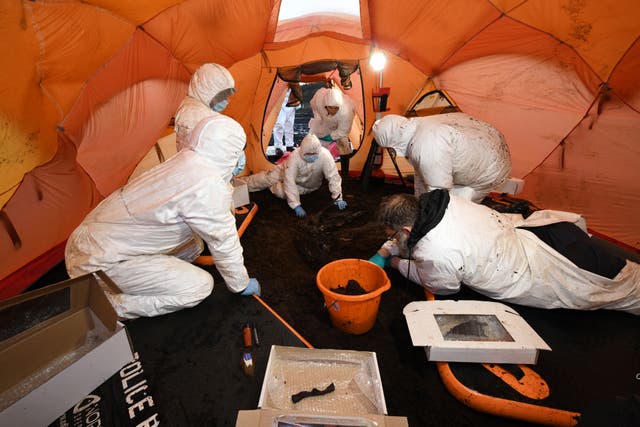Ancient remains discovered in Bellaghy bog ‘likely to belong to young woman’
The Ballymacombs More Woman has been hailed as ‘one of the most important archaeological discoveries on the island of Ireland’.

Ancient human remains uncovered in a Co Londonderry bog are believed to belong to a young woman who lived around 2,000 years ago.
Further research has been carried out following the discovery of the now named Ballymacombs More Woman in bogland near Bellaghy in 2023.
It had previously been thought that the remains belonged to a boy aged between 13 and 17 at the time of death.
Now it is thought the remains likely belonged to a women aged between 17 and 22 years, and has been hailed as “one of the most important archaeological discoveries on the island of Ireland”.

The study, led by National Museums NI, has involved collaboration with organisations across the UK, Ireland and Europe, including the Police Service of Northern Ireland (PSNI), National Museums of Ireland, Queen’s University Belfast, Trinity College Dublin, University College Dublin, University of Copenhagen, University of Glasgow, and University of Bradford.
The remains have been dated to approximately 343 BCE to 1 BCE, during a period known as the Iron Age.
Osteoarchaeological analysis has revealed the body to be female, a discovery described as “all the more significant as the majority of bog preserved individuals that have been found from this period are male”.
The individual had an estimated height of around 5ft 6in.
While the body was well preserved, the skull was absent and was not recovered. Research found that cut marks on the neck vertebrae indicate the cause of death as an intentional decapitation in the bog, which may be part of a pattern of ritual and sacrifice during the Iron Age period.
Part of a woven item made of plant material was also recovered from below the knees and is thought to be part of an associated artefact.
The museum is currently working with specialists to identify what this artefact could potentially be and are describing it as a woven plant-based fabric, likely associated with the individual and dating to this period.
In line with the naming convention applied to similar discoveries, ie, the townland where remains are found paired with the sex of the individual, the remains are now to be referred to as the Ballymacombs More Woman.
Niamh Baker, Curator of Archaeology at National Museums NI, said the Ballymacombs More Woman is “one of the most important archaeological discoveries on the island of Ireland”.
“This important discovery gives us a glimpse into the lives of the people of our ancient past and offers insights into how they lived, interacted with their environment, and developed their cultures,” she said.
“As the organisation with statutory responsibility for acquiring, curating and conserving nationally significant archaeological finds in Northern Ireland, we immediately understood how a thorough research process would be required to ensure that this discovery was managed professionally and ethically to unlock her valuable story.”
Eileen Murphy, Professor of Archaeology at the School of Natural and Built Environment at Queen’s, carried out the osteological assessment which provided a biological profile for the individual and ascertained the cause of their death.
“It was a privilege to undertake the osteological analysis of these important, but also very poignant, archaeological human remains,” she said.
“As is the case for so many Iron Age bog bodies, the young woman suffered a highly violent death which involved the flow of blood from her throat followed by decapitation.
“The head was taken away, but the body was left where it fell only to be discovered by machine workers some 2,000 years later. Further scientific analysis, including the conclusion of an aDNA analysis, will no doubt yield more fascinating findings.”
The remains and artefact have now been transferred from the State Pathology Laboratory to National Museums NI where they are currently being closely monitored by the conservation team before a final phase of preservation treatment.
Hannah Crowdy, Head of Curatorial at National Museums NI, described the collaboration as a “significant feat for Northern Ireland”.
“It is a brilliant illustration of how relevant our museums are, and the important role we play in connecting our unique heritage, spanning thousands of years, to the present day,” she said.
“We are exceptionally grateful to our partners for their collaboration on this project; we have all learnt from their considerable expertise, which will ensure we have rigorous, scientific records associated with this discovery.
“Our collections are for the public to enjoy and be inspired by, but as the Ballymacombs More Woman demonstrates, they are also a crucial resource for research and learning in a wide array of specialist fields.
“The stories and intrinsic knowledge associated with people from the past may be strange and disturbing to us today but also enlightening, helping us to better understand and reflect upon societal changes over time.
“Our views of the world, and the forces that impact upon us, have changed profoundly over the course of history. As we consider this important archaeological discovery, we should remind ourselves that Ballymacombs More Woman was once a person, just like us.”
This Saturday, National Museums NI and Queen’s University Belfast will take part in a symposium at the Seamus Heaney HomePlace.
The event, titled Digging into the Bog: Archaeological Finds & the Work of Seamus Heaney, will see experts discussing the Ballymacombs More Woman.
For more information on National Museums NI’s research and conservation work visit nationalmuseumsni.org.





